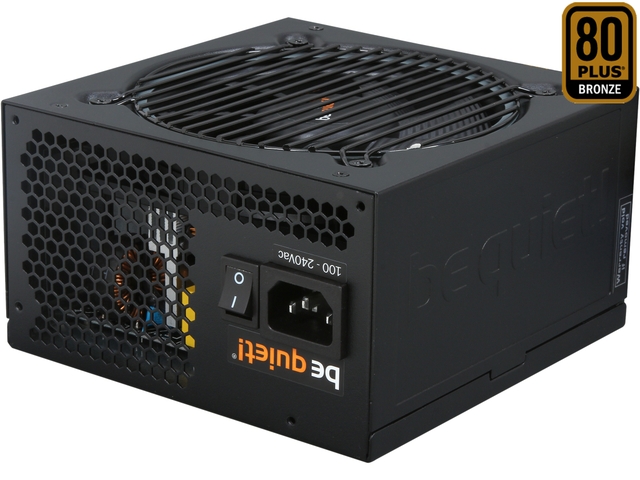be quiet! Pure Power 9 600W PSU Review
be quiet! released the updated Pure Power 9 series that consists of four semi-modular models with capacities ranging from 400W to 700W. Today, we're looking at the 600W implementation to see where it stands in the competitive mainstream market.
Why you can trust Tom's Hardware
Load Regulation, Hold-Up Time And Inrush Current
To learn more about our PSU tests and methodology, please check out How We Test Power Supply Units.
Primary Rails And 5VSB Load Regulation
Load Regulation testing is detailed here.
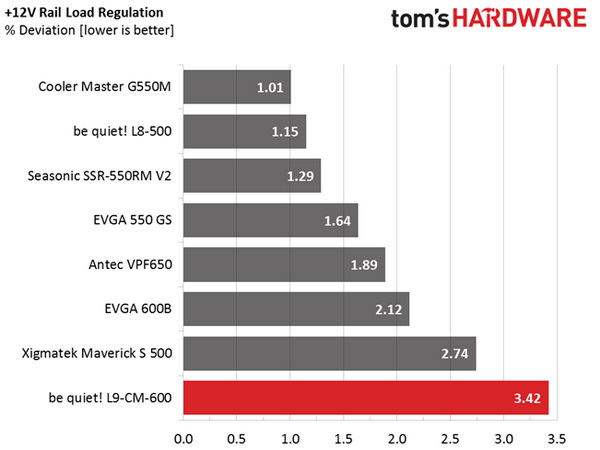
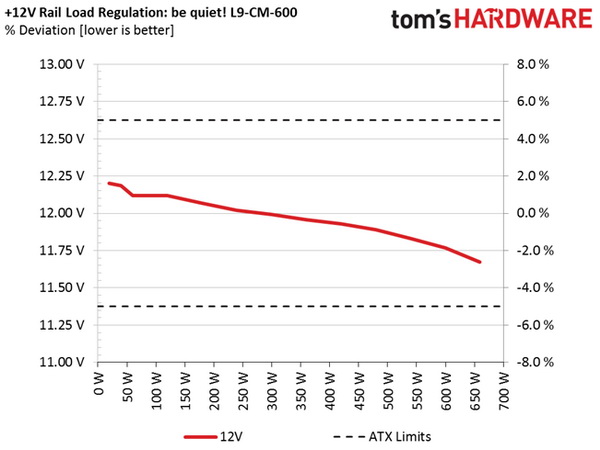

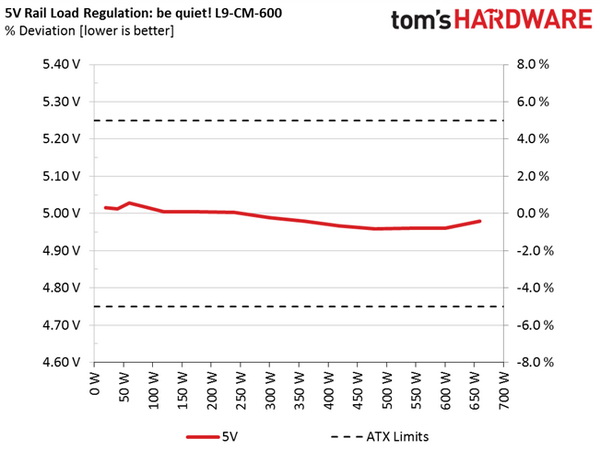
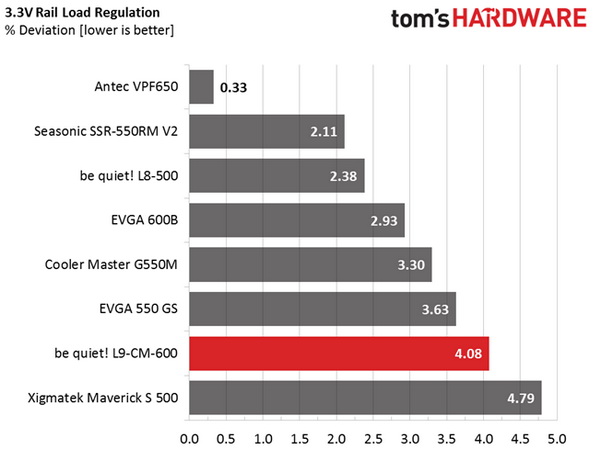
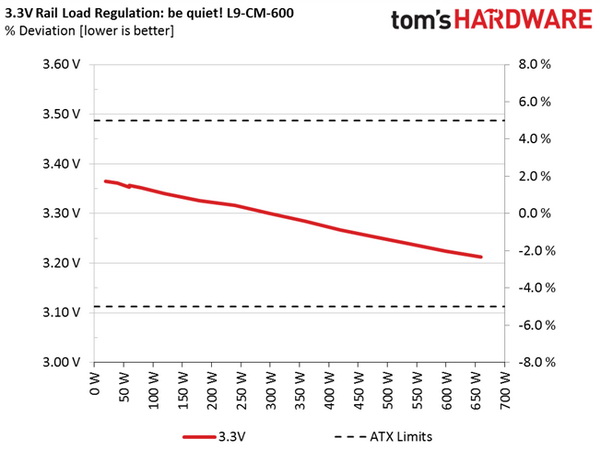
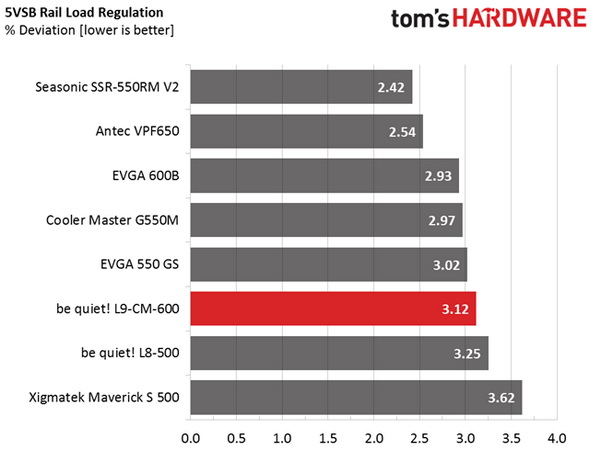
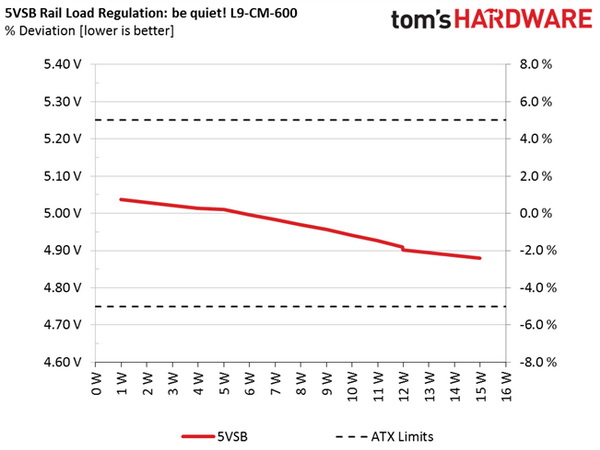
Hold-Up Time
Our hold-up time tests are described in detail here.
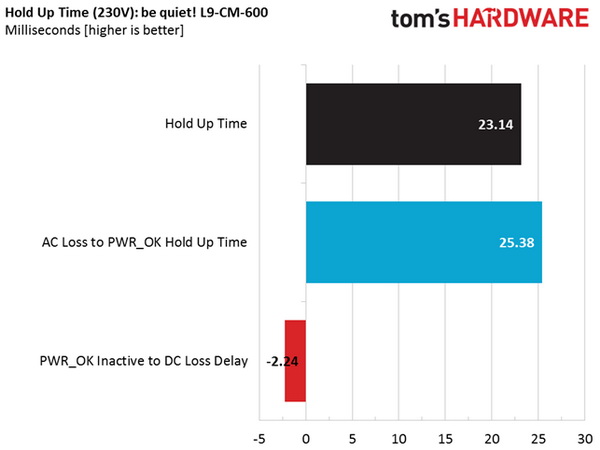

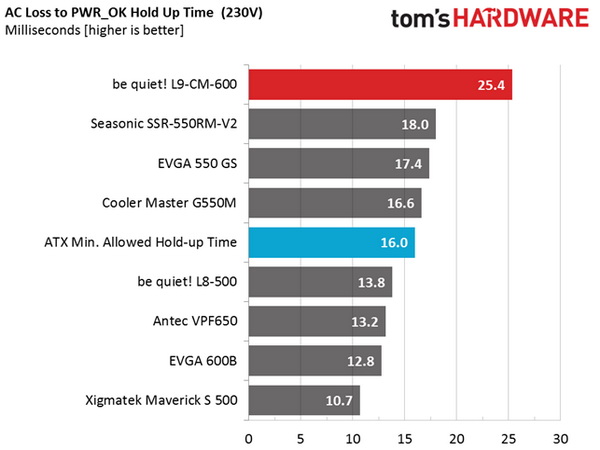

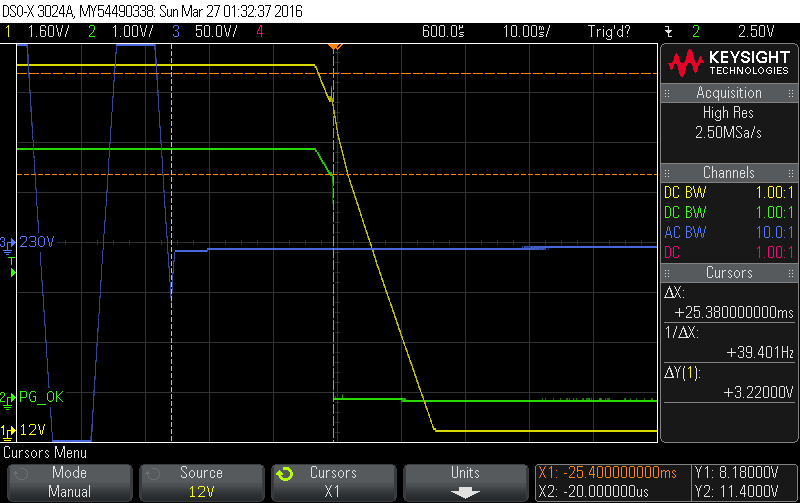
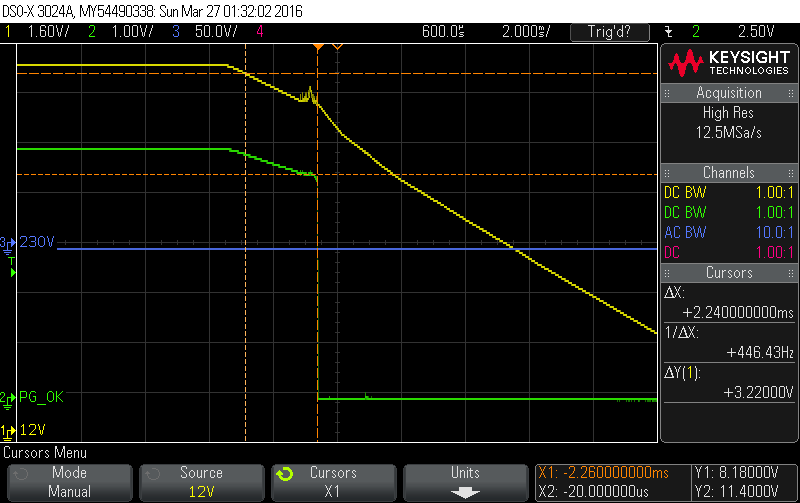
The hold-up time is much longer than the ATX spec's minimum requirement. But there's a catch. The power-good signal lasts longer, so when it drops, the voltage level of the +12V rail is already below 11V. This can lead to huge stress on the voltage regulators of the parts inside your PC. Fortunately, FSP should be able to fix the issue easily.
Inrush Current
For details on our inrush current testing, please click here.
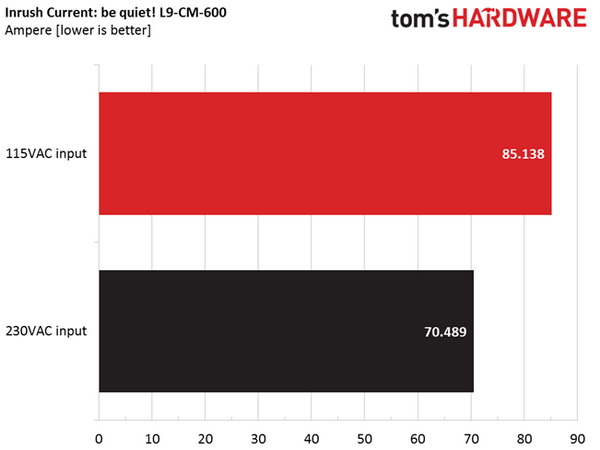
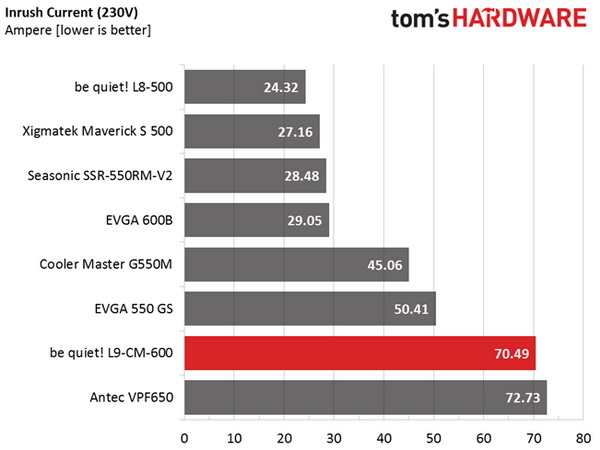
The lack of an NTC thermistor leads to high inrush currents.
Load Regulation And Efficiency Measurements
The first set of tests reveals the stability of the voltage rails and the PSU's efficiency. The applied load equals (approximately) 10 to 110 percent of the maximum load the supply can handle, in increments of 10 percentage points.
Get Tom's Hardware's best news and in-depth reviews, straight to your inbox.
We conducted two additional tests. During the first, we stressed the two minor rails (5V and 3.3V) with a high load, while the load at +12V was only 0.10A. This test reveals whether a PSU is Haswell-ready or not. In the second test, we determined the maximum load the +12V rail could handle with minimal load on the minor rails.
| Test # | 12V | 5V | 3.3V | 5VSB | DC/AC (Watts) | Efficiency | Fan Speed (RPM) | Noise (dB[A]) | Temps (In/Out) | PF/AC Volts |
|---|---|---|---|---|---|---|---|---|---|---|
| 1 | 3.146A | 1.993A | 1.966A | 0.996A | 59.80 | 85.38% | 565 | 17.5 | 36.88 °C | 0.967 |
| 12.150V | 5.015V | 3.353V | 5.011V | 70.04 | 39.24 °C | 115.1V | ||||
| 2 | 7.340A | 2.989A | 2.960A | 1.200A | 119.78 | 89.08% | 565 | 17.5 | 38.84 °C | 0.983 |
| 12.117V | 5.005V | 3.340V | 4.996V | 134.47 | 42.04 °C | 115.1V | ||||
| 3 | 11.917A | 3.497A | 3.479A | 1.401A | 179.88 | 89.92% | 565 | 17.5 | 39.20 °C | 0.989 |
| 12.069V | 5.004V | 3.326V | 4.983V | 200.05 | 42.69 °C | 115.0V | ||||
| 4 | 16.522A | 3.993A | 3.974A | 1.608A | 239.76 | 89.90% | 565 | 17.5 | 39.64 °C | 0.994 |
| 12.021V | 5.003V | 3.316V | 4.970V | 266.70 | 43.55 °C | 115.1V | ||||
| 5 | 20.788A | 5.005A | 4.992A | 1.814A | 299.70 | 89.47% | 565 | 17.5 | 40.83 °C | 0.996 |
| 11.991V | 4.989V | 3.300V | 4.956V | 334.96 | 45.13 °C | 115.1V | ||||
| 6 | 25.084A | 6.023A | 6.019A | 2.020A | 359.70 | 88.60% | 680 | 18.7 | 42.13 °C | 0.997 |
| 11.958V | 4.980V | 3.284V | 4.941V | 405.98 | 47.10 °C | 115.1V | ||||
| 7 | 29.387A | 7.039A | 7.059A | 2.230A | 419.60 | 87.84% | 865 | 22.0 | 43.05 °C | 0.998 |
| 11.930V | 4.967V | 3.267V | 4.927V | 477.68 | 48.43 °C | 115.1V | ||||
| 8 | 33.755A | 8.067A | 8.102A | 2.439A | 479.64 | 86.83% | 1040 | 27.0 | 44.58 °C | 0.998 |
| 11.889V | 4.958V | 3.253V | 4.910V | 552.42 | 50.40 °C | 115.1V | ||||
| 9 | 38.645A | 8.566A | 8.664A | 2.444A | 539.66 | 85.60% | 1220 | 33.0 | 45.13 °C | 0.998 |
| 11.829V | 4.961V | 3.238V | 4.902V | 630.48 | 51.28 °C | 115.1V | ||||
| 10 | 43.332A | 9.071A | 9.194A | 3.071A | 599.51 | 84.18% | 1350 | 33.7 | 45.69 °C | 0.997 |
| 11.767V | 4.960V | 3.224V | 4.880V | 712.14 | 52.45 °C | 115.1V | ||||
| 11 | 48.813A | 9.041A | 9.228A | 3.077A | 659.45 | 82.42% | 1700 | 37.1 | 47.00 °C | 0.997 |
| 11.673V | 4.980V | 3.212V | 4.871V | 800.13 | 54.57 °C | 115.1V | ||||
| CL1 | 0.101A | 17.018A | 17.004A | 0.003A | 135.02 | 79.07% | 1065 | 28.5 | 44.83 °C | 0.987 |
| 12.936V | 4.595V | 3.264V | 4.993V | 170.77 | 49.93 °C | 115.1V | ||||
| CL2 | 47.966A | 1.002A | 1.003A | 1.002A | 561.18 | 84.64% | 1325 | 33.5 | 46.19 °C | 0.998 |
| 11.420V | 5.160V | 3.268V | 4.950V | 663.00 | 53.59 °C | 115.1V |
The load regulation we measured is nothing to write home about. It's loose on all rails except for 5V. On the other hand, efficiency is quite high given this unit's 80 PLUS Silver rating. It's only during the full load test that the L9-CM-600W doesn't hit the required 85% mark. Then again, remember that we test in a hot-box with a high ambient temperature. We'll give be quiet! a pass there. At 20% and 50% load, efficiency is much higher than what it needs to be. ACRF topologies can meet 80 PLUS Gold requirements with the right components, so it's easy for the L9-CM-600 to hit Silver. In addition, noise levels are low even during the overload test.
In the cross-load tests (CL1 and CL2) you can clearly see that the +12V and 5V rails are regulated together, leading to poor results. According to Intel's taxing Haswell-Ready methodology, this unit clearly fails since it registers high voltage at +12V and below the limit at 5V during the CL1 test.
Current page: Load Regulation, Hold-Up Time And Inrush Current
Prev Page A Look Inside And Component Analysis Next Page Efficiency, Temperature And Noise
Aris Mpitziopoulos is a contributing editor at Tom's Hardware, covering PSUs.
-
turkey3_scratch Really poor unit. For one thing, the crossload performance is poor. Sleeve bearing fan with less reliability. 85C primary capacitor. Once again, another failed 3.3V transient response. Very high inrush current. Also, near worst of all, 140+mv of ripple on the 12V rail in CL2. Just really bad. And CL2 is a realistic scenario these days because those 3.3V and 5V rails don't do much anyway. FSP's soldering is clearly not the same as the nice soldering on their high end units.Reply
But my largest complaint would have to be voltage regulation (line regulation) under different load scenarios on page 6. -
4745454b 85C main cap doesn't bother me that much. It should get airflow from the fan so unless the fan dies (and if it does 105C cap isn't going to help much.) or it gets clogged with dust you should be ok. As for the CL test what do you expect? It's a group regulated design so that's going to happen. It's like buying a super duty truck and then complaining you don't get 30MPG in town. What I find more bothersome is they can't seem to sell you what they claim on the box. If it's not C6 or C7 ready and not a group reg design, why claim so? I wonder if they shipped the wrong unit?Reply -
powernod Outstanding review by Aris as always! :)Reply
If only the PSU itself was outstanding as well:ouch:
-
basroil Looks like FSP is still mostly a second tier manufacture with those transient response and inrush... does it really hurt that much to put a shuntable thermistor like Seasonic and SuperFlower units have?Reply
For less than $10 more you can usually find excellent Seasonic and SuperFlower Leadex Gold units, which makes it really hard to say this PSU is anything more than "meh" -
Aris_Mp actually I am worried about the bulk cap, because 85C means that it has 4x times lower lifetime than a 105C cap.Reply -
turkey3_scratch Reply17839248 said:85C main cap doesn't bother me that much. It should get airflow from the fan so unless the fan dies (and if it does 105C cap isn't going to help much.) or it gets clogged with dust you should be ok. As for the CL test what do you expect? It's a group regulated design so that's going to happen. It's like buying a super duty truck and then complaining you don't get 30MPG in town. What I find more bothersome is they can't seem to sell you what they claim on the box. If it's not C6 or C7 ready and not a group reg design, why claim so? I wonder if they shipped the wrong unit?
Not all group regulated designs are exactly the same way. We see in Seasonic's S12ii series a group regulated design that actually crossloads very well. This seems to be one of the worst on the ladder.
@Aris: Why is Inactive PWR_OK to DC_LOSS better at a higher value? Once the PWR_OK signal is dropped, wouldn't you want the unit to shut down as quickly as possible, not prolong it? -
powernod It was already explained by Aris at his review:Reply
"The power-good signal lasts longer, so when it drops, the voltage level of the +12V rail is already below 11V."
When the pwr_ok to DC_loss is higher (*meaning that it has a positive , not negative value) that means that the motherboard will already have been shut-down. (*from what i've understand, at least) -
turkey3_scratch Not sure how the motherboard could shut down before the PWR_OK signal is dropped.Reply -
Aris_Mp the problem is that in some PSUs, PWR_OK, which informs the mainboard when it should shut down, drops after and not before the rails go our of spec. So once it drops the rails are already too low.Reply
Normally when AC is removed, the PWR_OK signal should be de-asserted at least 1ms before voltages go out of spec in order not to stress the VRMs of the mainboard and of other components (e.g. VGA, HDD, SSD, etc.).
The only way to address this issue is to have a circuit on the mainboard checking the input voltages and give the shut down order when these go out of spec. In other words to completely bypass the power_ok signal coming from the PSU. But this will cost money and after all a PSU oughts to follow ATX spec's guidelines. -
turkey3_scratch So is "DC_LOSS" considered "voltages out of spec"? I mean, there can still be DC even if voltages are out of spec. It won't be a loss of DC< just an out-of-spec voltage relative to the DC.Reply
